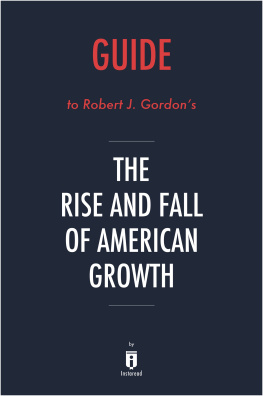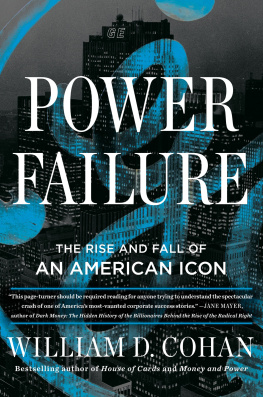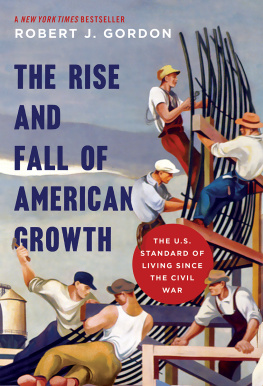Guide to
Robert J. Gordons
The Rise and Fall of American Growth
The U.S. Standard of Living Since the Civil War
by
Instaread
Please Note
This is a companion to the original book.
Copyright 2016 by Instaread. All rights reserved worldwide. No part of this publication may be reproduced or transmitted in any form without the prior written consent of the publisher.
Limit of Liability/Disclaimer of Warranty: The publisher and author make no representations or warranties with respect to the accuracy or completeness of these contents and disclaim all warranties such as warranties of fitness for a particular purpose. The author or publisher is not liable for any damages whatsoever. The fact that an individual or organization is referred to in this document as a citation or source of information does not imply that the author or publisher endorses the information that the individual or organization provided. This concise companion is unofficial and is not authorized, approved, licensed, or endorsed by the original books author or publisher.
Table of Contents
Overview
The Rise and Fall of American Growth is an analysis of American growth from 1870 to the present. It focuses especially on the unprecedented special century of 1870-1970.
Throughout most of human history, economic growth was basically flat or advanced very slowly. After the Civil War in the United States, however, life began to improve exponentially. This was due to a series of Great Inventions, including, most notably, electricity, the means of channeling and directing electricity, and the internal combustion engine. Homes became tied to systems of electricity, heat, and sewage. The last was particularly important, as cleaner water, abetted by new medicines that immunized against childhood disease, led to a dramatic drop in infant and child mortality.
The progress between 1870 and 1970 is routinely underestimated by measures of gross domestic product (GDP) because GDP does not measure the quality of life improvement by increased life expectancy. GDP also does not adequately measure the improvement in job conditions as new technology meant that men shifted from physical labor on the farm to less grueling jobs. Women no longer had to spend their days hauling water into the home and could begin to join the workforce.
After 1970, progress slowed. The Great Inventions could only be invented once. Once electricity, automobiles, and running water were widely available, they could not be developed and made widely available again.
The one area of continued progress since 1970 has been in communications technology. The development of desktop computers, the Internet, search engines, and cell phones contributed to a modest upswing in growth in 1994-2004. However, advances in communications cannot transform society in the way that the inventions of the special century did.
Future growth in the United States faces a number of obstacles. Rising inequality, an aging population, an underperforming educational system, and the breakup of the American family have slowed growth. Even if these problems are addressed, however, growth is unlikely to return to the level of the special century. The United States needs to take steps to improve the welfare of its citizens while recognizing that the miraculous growth rates of the special century cannot be repeated.
Important People
Robert J. Gordon is a professor of economics at Northwestern University. In addition to The Rise and Fall of American Growth, he has written a number of other books including Macroeconomics (2002) and The Measurement of Durable Good Prices (1990).
Henry Ford (1863-1947) was an industrialist best known for standardizing the production of the early automobile, thereby making cars widely available and affordable.
Thomas Edison (1847-1931) was an American inventor who created the first commercially viable, long-lasting electric light bulb.
Karl Benz (1844-1929) was a German inventor credited with developing the first internal combustion engine for the automobile.
Alexander Graham Bell (1847-1922) was an American inventor who patented the first telephone.
Robert M. Solow is a Nobel Prize-winning economist who is famous for isolating the amount of growth attributable to technical progress.
Key Insights
- Great inventions can only be invented once. Growth associated with those inventions is therefore unique and cannot be duplicated.
- Measures of GDP greatly understate the growth and impact of the great inventions on peoples lives during the special century.
- It can take many decades for inventions to have their full impact on growth via secondary inventions and improvements.
- The linking of homes to heating, electrical, and sewage systems was one of the central advances of the special century, and was particularly important to increases in life expectancy.
- The Great Depression and World War II helped fuel growth.
- Technological improvements in telecommunications and entertainment from the 1990s through the 2010s cannot transform society as did the great inventions of the special century.
- The United States faces major obstacles to growth, including inequality, aging demographics, and educational underachievement.
- Even if the United States overcomes obstacles to growth, the country will not return to the growth rates of the special century.
Analysis
Key Insight 1
Great inventions can only be invented once. Growth associated with those inventions is therefore unique and cannot be duplicated.
Analysis
Thomas Edison developed a functional, long-lasting electric light bulb in October 1879. Ten weeks later, Karl Benz developed a workable internal combustion engine. These two inventions transformed life in the United States over the next century. Homes that had once been dark could now be lit. Similarly, the car made long-distance travel convenient and easy and ended reliance on horses, with their inefficiencies and vast quantities of manure.
Electricity and automobiles created the modern world. But that modern world could only be created once. The same can be said of other developments, such as working sewage systems, or penicillin, or the Internet. Inventions can spur fantastic growth, and this growth can last for some time. But inventions do not result in continuous growth. Once their impact has been absorbed, only new inventions can lead to new growth.
One way to think about the one-time-only nature of the great inventions of the past is to try to imagine what it would take to spur a similar technological revolution in the 2010s. Elaborations on earlier inventions, such as driverless cars, would result in minor alterations in peoples lives, but not in wholesale transformations as the great inventions did.
Science fiction is filled with imagined inventions that could be as transformative as the great inventions of 1870-1970. For instance, if someone developed the kind of teleportation technology described in Star Trek and other works of science fiction, standards of living and everyday life could change drastically. At first, there might just be a large drop in the price of goods and materials as shipping costs disappeared. Over time, as the technology became more efficient and portable, public transportation and cars could disappear. Cities could be transformed; travel around the globe would be instantaneous, rearranging and reinventing entire industries. Even buildings might change in structure; they might no longer need doors or entryways.
Once the teleportation revolution happened, though, it could not happen again. Teleportation would cause massive growth and unpredictable, perhaps unimaginable, changes in every area of peoples lives. But the changes would be unique; they would not generate growth forever. Instead, for there to be more growth, there would need to be more inventionsin nanotechnology, perhaps, or bioengineering.
Next page















